History and Identification Characteristics of
Fred Locke Multipart Porcelain Insulators
Go to Main Page
Go to: Fred Locke Multipart Insulator Styles
Go to Page 1 Page 2 Page 3 Page 4 Page 5 Page 6
Fred M. Locke was the first person to introduce large cemented multipart insulators in North America. He pioneered the production of very large pin type insulators several years before other manufacturers made them available. Mr. Locke began experimenting with cemented designs sometime in 1897 but none of these ever made it into large scale production or are known to have been used on lines some of these experimental pieces were produced by Imperial Porcelain works. A few of these designs were found in the Attic dig by Jeff Katchko and Ken Willick. Some of these also appear to be of very early victor production from the 1898-1899 era and a few small fragments of these likely Victor produced pieces were found in Victor.
Combination insulators: Imperial cross-tops for cemented porcelain or glass bases
Early Fred Locke multiparts were very prone to cement joint expansion cracking the skirts causing electrical puncture in service. Numerous specimens found by collectors show a very high failure rate on some lines. One historical account written around 1915 described a nearly 90% failure rate of the M-4325 on a line in Washington state from cement expansion and puncture (they have very little lightning there so these failures were, for the most part, not lightning related. The author has personally observed M-2842A, M-3061, M-3236, and M-4325 specimens in the field that clearly punctured in service.
Multipart production at the victor plant started on a large
scale in 1900 with production of the M-2795 gutter spout insulators. Only one or
two other designs were produced in any quantity in this era. The number of
designs that actually made it into service on lines or large-scale production
(that are known by collectors from this production era) is limited to the
M-2334, M-2842 M-2795 and M-2796 at this time.
Multipart production after the fire in the winter of
1902-02.
After the Victor plant was rebuilt from a devastating
winter fire in late December of 1901 production of larger multipart designs
expanded rapidly and became the dominant product of the factory during the time
Fred Locke was involved with the Locke Company.
Because no knowledge of how to work the clay bodies to make large porcelain insulators of plastic clay existed at this time in history, a great deal of experimentation was going on at the victor plant to learn to make these larger insulators on a large scale. The emphasis was likely on ways to increase production speed and reduce labor input rather then overall quality of the ware. All of the early multipart tops from 1900-1901 were produced by a rather time consuming process of pressing individual parts and then fitting them together with clay slip or glaze welding.
All of the multiparts made in 1900 and 1901 had what collectors call "applied crowns" the body of the top skirt and top crown were made separately and then mated with clay slip once they were partly dried, the collar sections were then attached with clay slip.
This was a very time consuming process and with large orders flooding the factory they had to find a faster way.


Applied crowns on M-2795.
On the early 1900-1901 gutters a separate rope of clay was laid into the platter mold that was pressed into the platter to form the upturned rim of the insulator. This seems to have ended in mid-1901 as was seen in the many dated specimens found in the now famous Nicholas, California insulator dig.
In early 1902 two-part molds were introduced for all
designs except the gutter designs that required applied crowns for engineering
reasons. These mold sets produced a
full mold line over the entire insulator top shell from rim edge to rim edge.
The only post-1901 multiparts known with applied crowns are the M-2335A and
M-2785 gutters.
This two-part mold production technique only lasted until
around the spring of 1903 (when marking 7-1 was introduced). They obviously had
problems with mold alignment and many insulators in collections from this time
are lopsided and offset at the mold because of mold misalignment issues. This
method did eliminate the applied crown problems from before but obviously did
not work well. Nearly all two-part mold multipart insulators have marking 6-1.
The following M-numbers have been found with two-part mold
characteristics: M-2250 (only one known), M-2332, M-2842B (all known specimens),
M-2998 (all known specimens), M-3061, and M-3725.
------add photos of two-part mold specimens with good clear
mold lines here------------
In 1903 a new mold set design was introduced that was a
modified three part design that created a mold line that only extends to a point
just beyond the edge of the tie wire groove and does not extend to the skirt rim
edge. The mold line circles the crown and also splits the crown in half.
This mold design eliminated the issues with mold misalignment and created a much
more uniform round skirt rim surface.
The following M-numbers have been found with this
characteristic: M-2202, M-2250, M-2332, M 2430, M-3060, M-3061, M-3062A,
M-3150A, M-3236, M-3721, M-3721B, M-4325, and M-4384.
Only one other manufacturer copied the Locke technique of making tops in three part molds and only very briefly. This was the New Lexington High Voltage Porcelain Co. the only NL style known with this characteristic is the M-4325A produced in 1903-04.
---------------add photo of any large specimen(s)
with crown ring mold line here. Also photo of M-2430 with raised ridge around crown compared
to a later flat victor specimen. ---------------------------------
In 1904 the first multipart tops that were produced by the
modern method of "green trimming" appeared. These were made in a
one-part mold without a tie wire groove and were turned on a potter’s wheel to
add the tie wire groove. These have no visible mold line.
Only three styles have been found that can be attributed to Fred M. Locke
with these characteristics or markings. These are M-3721B, M3721A, and M-4384.
By the end of 1905 all multipart produced at victor were
"green trimmed" making the appearance of mold lines on multipart tops
a defining characteristic of most all Fred Locke multiparts produced from
1902-1904.
--------------------------- Add photo of green trimmed
M-4384 crown here-------------------------------
Trimmer letter or number codes on early Locke multiparts.:
Typically early Fred M. Locke multiparts of 1902-04 have a
large number, letter or small letter stamped on the underside. Around 1905 this
ended and small letters were stamped into the crown instead of the underside of
the top.
Insulators with large crudely stamped numbers on the
underside of the top skirt which also have mold lines and identifiable early
Locke glazes are considered to be Fred Locke pieces by collectors. If a
multipart has a letter code stamped on the crown it is likely a later Victor
product cir 1905-1910.
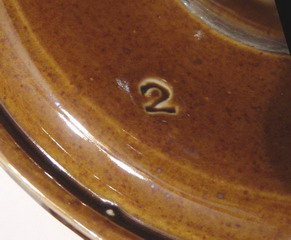
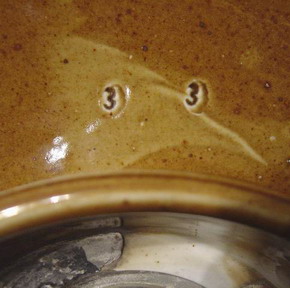
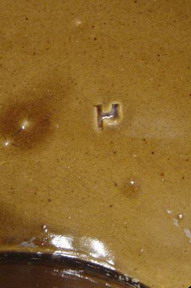
White glazed Fred Locke multiparts are extremely rare. Thus
far the only white styles found are M-2795 and M-2430 (top only) pieces of other
white multiparts have been found in the dump but none are known to have seen
service on actual lines.
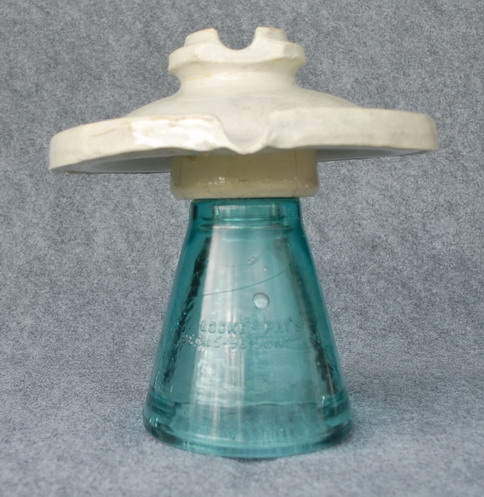
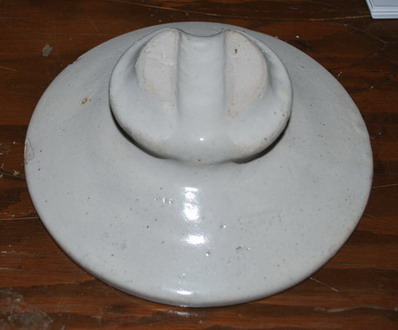

M-2795 and top to M-2430.
Pinholes in Fred Locke multiparts:
The first large porcelain lower multipart skirts
appeared in early 1901. There is some evidence that formation of clean threads
was a problem in these early large skirts. Some specimens from 1901-1902
appear to have had the threads formed separately as a clay thimble that was
plunged into the larger clay body of the skirt during manufacture rather then in
the main skirt clay body itself. Also a few M-2796 skirts have been found with a
glaze-welded in thread thimble. Whether this glazeweld insert was an experiment
to deal with thread formation difficulties or to increase the puncture
resistance of the skirt itself is unknown.
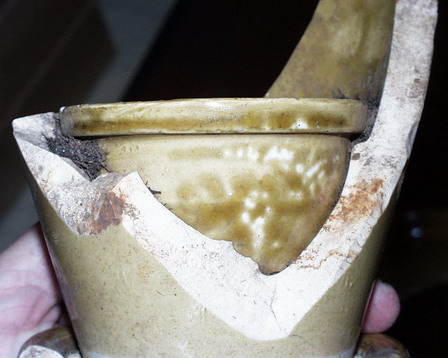
Glazewelded threaded insert in M-2796.
Most Fred Locke multiparts have glazed pinholes. The only
ones with unglazed pinholes are M-2332 (one known) M-2430, M2250, M-3060,
M-3061, and M-3062A.
With the exception of the M-2335A, all Fred Locke multiparts have 1 3/8” threaded pinholes.
Go to: Fred Locke Multipart Insulator Styles
Go to Page 1 Page 2 Page 3 Page 4 Page 5 Page 6
Go to Main Page